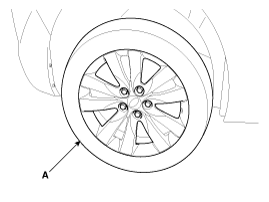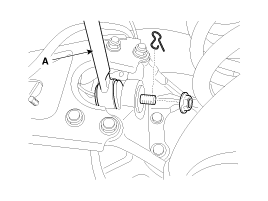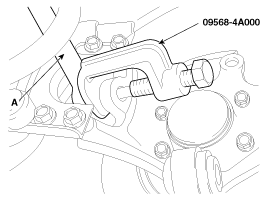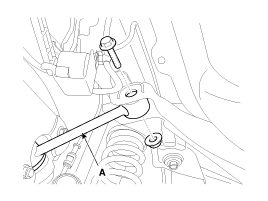Kia Cee'd: Rear Suspension System / Rear Assist Arm Repair procedures
Kia Cee'd JD Service Manual / Suspension System / Rear Suspension System / Rear Assist Arm Repair procedures
| Replacement |
| 1. |
Loosen the wheel nuts slightly.
Raise the vehicle, and make sure it is securely supported.
|
| 2. |
Remove the rear wheel and tire (A) from rear hub.
|
| 3. |
Remove the rear shock absorber.
(Refer to Rear Suspension System - "Rear Shock Absorber")
|
| 4. |
Remove the sprit pin and castle nut and then disconnect the rear assist
arm (A) from the rear axle.
|
| 5. |
Using the SST (09568-4A000), disconnect the assist arm (A) from the
carrier assembly.
|
| 6. |
Loosen the bolt & nut and then remove the rear assist arm (A) from the
sub frame.
|
| 7. |
Install in the reverse order of removal.
|
| Inspection |
| 1. |
Check the bushing for wear and deterioration.
|
| 2. |
Check for all bolts and nut.
|
 Rear Stabilizer Bar Repair procedures
Rear Stabilizer Bar Repair procedures
Replacement
1.
Loosen the wheel nuts slightly.
Raise the vehicle, and make sure it is securely supported.
2.
Remove the rear wh ...
 Trailing Arm Repair procedures
Trailing Arm Repair procedures
Replacement
1.
Loosen the wheel nuts slightly.
Raise the vehicle, and make sure it is securely supported.
2.
Remove the rear wh ...
Other information:
Kia Cee'd JD Service Manual: Speakers Repair procedures
Inspection
1.
Troubleshooting for Speaker
(1)
Basic inspection of speaker
Inspect the sound from speaker after verifying that the speaker
mounting screws are removed and the wiring connector is connected
to ...
Kia Cee'd JD Service Manual: Repair procedures
Replacement
1.
Loosen the wheel nuts slightly.
Raise the vehicle, and make sure it is securely supported.
2.
Remove the rear wheel and tire (A) from rear hub .
Tightening torque:
88.2 ~ ...
© 2017-2026 www.kceed.com






